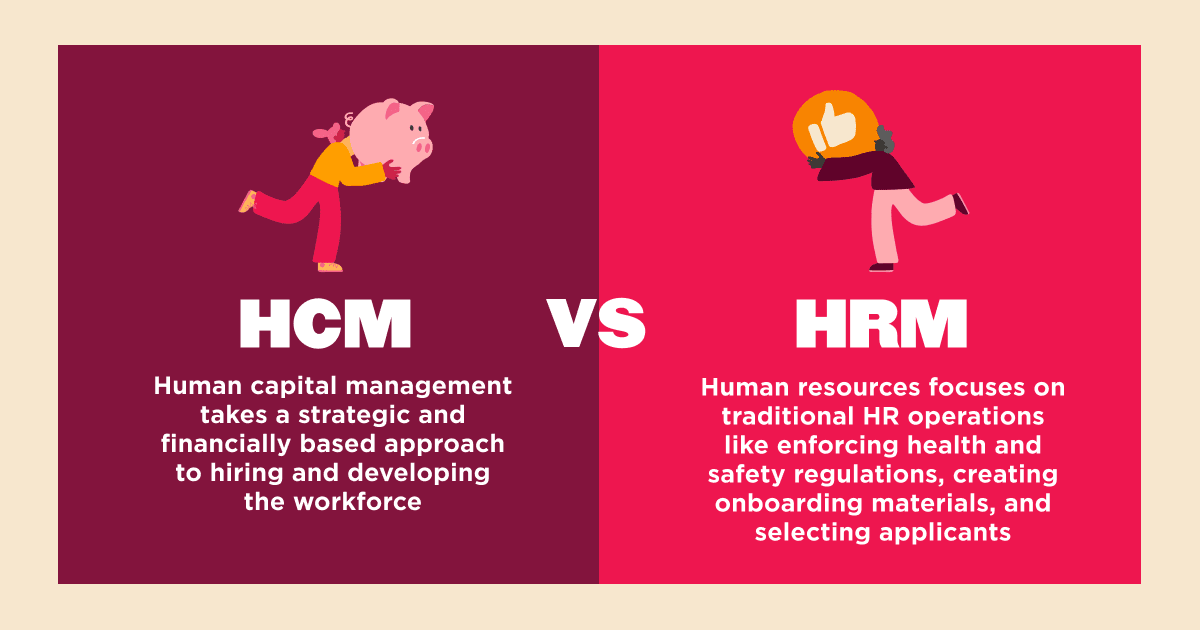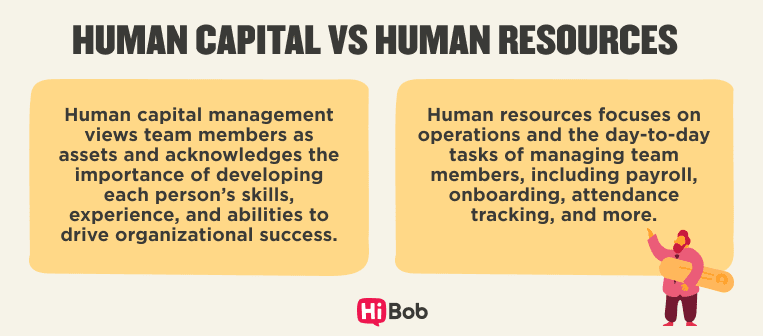Both human resources and human capital strategies emphasize the importance of team members to the success of an organization—and both leverage HR tech to improve performance and track important data.
However, each concept approaches people management from a different perspective and focuses on separate tasks and goals.
Key insights
- Human capital focuses on strategic development and long-term value creation by treating team members as valuable assets
- Human resources manage daily operations such as compliance, recruitment, and payroll, ensuring organizational efficiency
- Both functions are people-centric, prioritizing skill development and team member wellbeing to maximize potential
- Understanding the differences and interactions between human capital and human resources helps organizations balance immediate needs with long-term growth

Human capital vs human resources
Human capital management takes a strategic and financially based approach to hiring and developing the workforce. In contrast, the traditional role of human resources focuses on HR operations like enforcing health and safety regulations, creating onboarding materials, and selecting applicants for open roles.
Let’s take a look at the differences between human capital and human resources.
What is human capital?
Human capital management considers team members through the lens of the skills, knowledge, experience, and monetary value of the organization each person represents. It views team members as assets and acknowledges the importance of developing each person’s skills, experience, and abilities to drive organizational success.
Teams invest in skill development and performance management to ensure every team member can contribute to organizational goals. This approach plans strategically for future skill needs and team development gaps.
While human resources workflows differ from human capital management strategies, they work together to create a comprehensive and proactive plan for managing a high-performing workforce primed for growth.
What is human resources?
Human resources teams manage an organization’s workforce. A typical HR functions list includes recruitment, talent and performance management, employee engagement initiatives, compensation and benefits, and much more. HR teams also oversee legal and compliance aspects of workforce management.
HR functions directly impact human capital initiatives—and a single team often manages these two concepts. For example, recruiting and hiring constitute key human resources duties. When human resources teams strategically hire new team members who fit the bill for current and future needs, they help optimize human capital.
Likewise, human capital focuses on learning and development, which is another core function of the human resources team. While the terms are not interchangeable, the two functions interact heavily within a typical organization.

Similarities between human resources and human capital
Understand the similarities between human resources and human capital to make strategic plans around people management.
People-centric
Human resources and human capital focus heavily on the people within an organization. They prioritize team member skill development, performance and talent management, and employee wellbeing. Both human resources and human capital seek to maximize the potential and value of every team member and provide opportunities for growth.
A people-centric approach helps organizations foster an engaging work environment and maximize their investments in each team member. An organization’s success hinges on the skills, productivity, and development of its people.
Organizations can boost innovation and engagement through supportive actions, including:
- Offering skill development opportunities and continuous learning
- Prioritizing job enrichment strategies to keep team members engaged
- Evaluating compensation and benefits packages against industry standards
- Seeking out feedback from team members at every level
- Recognizing achievements and milestones
- Communicating feedback and next steps in an actionable way to encourage growth
These people-centric steps allow for honest communication and an atmosphere of improvement, which will motivate team members and optimize progress toward organizational goals.
Data-driven
Human resources and human capital teams use data to make informed decisions and formulate future plans. They measure metrics like employee productivity and retention, time to hire, employee satisfaction, and turnover rates.
They then analyze this data to optimize talent management strategies, predict future organizational needs, and improve workforce planning.
Automation
Human resources and human capital professionals can save time and streamline repetitive tasks through automation and advanced HR software. Since both teams own countless people management workflows, automation ensures optimal efficiency and accuracy.
For example, human resources teams may use automated payroll software to calculate salaries, deductions, and benefits efficiently and accurately.
Within human capital strategies, automation solutions can help track team member data to identify skill potential and suggest the best path for learning and development. An automated system can analyze performance data, self-declared goals, projected openings, and skill gaps to tailor a training program for each team member.
Compliance
While human resources teams work more in compliance, human resources, and human capital teams take responsibility for legal and regulatory requirements.
They ensure compliance with labor laws, workplace safety standards, and industry-specific regulations. This helps prioritize team member’s health while protecting the organization from legal penalties.
What are the differences between human resources and human capital?
Even though human resources and human capital have considerable overlap, these two functions vary in several ways.
Key focus
Conceptually, one of the largest differences between human resources and human capital lies in their perception of team members in the context of the organization. While human resources teams manage team members as a group to ensure high-level company functions take place, human capital teams treat team members as assets waiting for optimization and development.
Human resources focuses on operations and the day-to-day tasks accompanying managing team members. These tasks include hiring, managing payroll, and ensuring compliance.
The key focus of human capital lies in strategy and value. Human capital management looks into how to develop the workforce and invest in team members to drive long-term value and ensure business growth. Human capital may give more weight to each individual’s potential, while human resources focuses on the current skill set and experience of a given candidate or team member.
Long-term purpose
Human resources teams have a long-term administrative focus. They prioritize organizational compliance, address team member relations, and ensure HR processes move forward smoothly. This operational foundation allows for more intentional and strategic growth later on.
Human capital teams focus on long-term team member development, emphasizing the importance of obtaining new skills and knowledge that align with company goals. Human capital management seeks to optimize long-term returns on team member investments.
Approach
Human resources teams usually take a tactical approach and pay the most attention to immediate needs. For example, they strive to fill job openings as quickly and accurately as possible.
Human capital requires more of an investment outlook with an approach favoring long-term returns over short-term problem solving. This approach involves investing in skill development and training, quantifying the value each team member represents, and anticipating upcoming skill gaps.
These teams can also leverage different types of software and tools in their approach to people management. For example, HR teams may use an HRIS to manage basic functions and store data securely. At the same time, human capital professionals seek out HCM software that enables succession planning, career pathing, and business intelligence insights.
Learn more about human resources and human capital
Here are a few frequently asked questions about human capital vs human resources.
Are HR and human capital interdependent?
Yes, HR and human capital are interdependent. Organizations must address compliance, payroll, recruitment, and other HR duties before thinking strategically about optimizing their workforce’s value.
With a strong foundation in place, human capital teams can use HR documentation, data, and resources to maximize each team member’s value and develop long-term strategies for organizational success.
Together, HR and human capital initiatives create well-managed and happy teams with the precise skill sets needed for the organization’s specific goals. They also work together to create targeted training and development opportunities for the current workforce.
Why is it important to know the difference between human resources and human capital?
Organizations must understand the difference between human resources and human capital management to properly manage a workforce. This knowledge allows organizations to balance the logistical and operational aspects of HR with the longer-term investment perspective of human capital.
When organizational leaders understand these two functions holistically, they can better align their people management practices with broader business goals and long-term strategy. For example, a brand-new business can recognize the need to prioritize HR functions and then formulate a plan for integrating more forward-thinking human capital practices into its strategy.
Recommended For Further Reading
What is the difference between HRM and HCM?
HRM, or human resource management, and HCM both play a key role in a comprehensive HR strategy.
HRM involves managing team members, recruiting, payroll, and compliance. HCM, or human capital management, focuses on the strategy and long-term value behind workforce planning and development.
Choose the right HR solution for your business
Organizations at all stages need HR solutions capable of handling both HR and human capital functions. Organizations can leverage both approaches to create a well-rounded, effective people management strategy that addresses immediate needs while planning for future growth and development.
HR leaders can use this holistic approach to support their people while evolving to meet the ever-changing demands of the business landscape. This helps them foster a culture of continuous improvement, innovation, and sustainable success.


